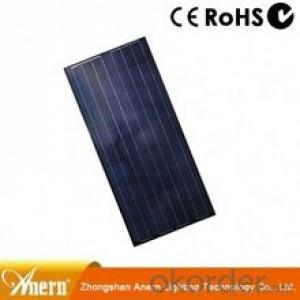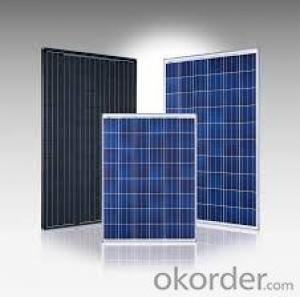Poly 156X156mm2 Solar Cells Made in Panels
- Loading Port:
- Shanghai
- Payment Terms:
- TT OR LC
- Min Order Qty:
- 2999 watt
- Supply Capability:
- 6000000 watt/month
OKorder Service Pledge
OKorder Financial Service
You Might Also Like
The operation of a photovoltaic (PV) cell requires 3 basic attributes:
The absorption of light, generating either electron-hole pairs or excitons.
The separation of charge carriers of opposite types.
The separate extraction of those carriers to an external circuit.
In contrast, a solar thermal collector supplies heat by absorbing sunlight, for the purpose of either direct heating or indirect electrical power generation from heat. A "photoelectrolytic cell" (photoelectrochemical cell), on the other hand, refers either to a type of photovoltaic cell (like that developed by Edmond Becquerel and modern dye-sensitized solar cells), or to a device that splits water directly into hydrogen and oxygen using only solar illumination.Characteristic of Mono 156X156MM2 Solar Cells
You are gaining energy independence - add battery backup power for even greater energy security
The cost of electricity is only going to rise – insure against that rising cost
Adaptive cells change their absorption/reflection characteristics depending to respond to environmental conditions. An adaptive material responds to the intensity and angle of incident light. At the part of the cell where the light is most intense, the cell surface changes from reflective to adaptive, allowing the light to penetrate the cell. The other parts of the cell remain reflective increasing the retention of the absorbed light within the cell.[67]
In 2014 a system that combined an adaptive surface with a glass substrate that redirect the absorbed to a light absorber on the edges of the sheet. The system also included an array of fixed lenses/mirrors to concentrate light onto the adaptive surface. As the day continues, the concentrated light moves along the surface of the cell. That surface switches from reflective to adaptive when the light is most concentrated and back to reflective after the light moves along
Mechanical data and design
Format | 156mm x 156mm±0.5mm |
Thickness | 210μm±40μm |
Front(-) | 1.5mm bus bar (silver),blue anti-reflection coating (silicon nitride) |
Back (+) | 2.5mm wide soldering pads (sliver) back surface field (aluminium) |
Temperature Coefficient of Cells
Voc. Temp.coef.%/K | -0.35% |
Isc. Temp.coef .%/K | +0.024%/K |
Pm.Temp.coef. %/K | -0.47%/K |
Electrical Characteristic
Effiency(%) | Pmpp(W) | Umpp(V) | Impp(A) | Uoc(V) | Isc(A) | FF(%) |
18.35 | 4.384 | 0.526 | 8.333 | 0.63 | 8.877 | 78.39% |
18.20 | 4.349 | 0.526 | 8.263 | 0.63 | 8.789 | 78.54% |
18.05 | 4.313 | 0.525 | 8.216 | 0.63 | 8.741 | 78.32% |
17.90 | 4.277 | 0.524 | 8.161 | 0.625 | 8.713 | 78.04% |
17.75 | 4.241 | 0.523 | 8.116 | 0.625 | 8.678 | 77.70% |
17.60 | 4.206 | 0.521 | 8.073 | 0.625 | 8.657 | 77.36% |
17.45 | 4.170 | 0.519 | 8.039 | 0.625 | 8.633 | 76.92% |
17.30 | 4.134 | 0.517 | 8.004 | 0.625 | 8.622 | 76.59% |
17.15 | 4.096 | 0.516 | 7.938 | 0.625 | 8.537 | 76.80% |
17.00 | 4.062 | 0.512 | 7.933 | 0.625 | 8.531 | 76.18% |
16.75 | 4.002 | 0.511 | 7.828 | 0.625 | 8.499 | 75.34% |
16.50 | 3.940 | 0.510 | 7.731 | 0.625 | 8.484 | 74.36% |




 FAQ
FAQ
Q: What price for each watt?
A: It depends on the quantity, delivery date and payment terms, generally Large Quantity and Low Price
Q: What is your size for each module? Can you tell me the Parameter of your module?
A: We have different series of panels in different output, both c-Si and a-Si. Please take the specification sheet for your reference.
Q: What is your size for each module? Can you tell me the Parameter of your module?
A: We have different series of panels in different output, both c-Si and a-Si. Please take the specification sheet for your reference.
- Q:Silicon solar cell power generation principle
- The expected efficiency of the theory is 24% .As the semiconductor PN junction device in the sun under the photoelectric conversion efficiency of the highest, so these photovoltaic devices are usually referred to as solar cells, also known as photovoltaic cells or solar cells.
- Q:How do solar cells perform in areas with extreme temperature fluctuations?
- Solar cells generally perform well in areas with extreme temperature fluctuations. While high temperatures can slightly reduce their efficiency, modern solar cell designs are often equipped with cooling mechanisms to mitigate this issue. Additionally, solar cells are tested and designed to withstand temperature variations, including freezing temperatures. Overall, solar cells are designed to be robust and reliable in varying climates, allowing them to generate electricity efficiently even in areas with extreme temperature fluctuations.
- Q:Can solar cells be used in disaster response vehicles?
- Yes, solar cells can be used in disaster response vehicles. They can provide a reliable and renewable source of power to charge essential equipment and devices, such as communication systems, lights, and medical equipment. Solar cells are especially useful in remote or off-grid areas where traditional power sources may be disrupted or unavailable during a disaster.
- Q:Can somebody list some of the materials used for making solar cells?
- Solar cells are typically named after the semiconducting material they are made of.
- Q:What is sun cells technology?
- Sun cells use high technology to change the sun's light energy into electrical energy. The sun cells can be used in the industries such as satellites, navigation lights, transistor radios and other power supply services.
- Q:What is the role of bypass diodes in solar cell systems?
- The role of bypass diodes in solar cell systems is to minimize the impact of shading or partial module failure. They allow current to bypass the shaded or malfunctioning cells, preventing them from reducing the overall performance of the system.
- Q:How do solar cells handle power fluctuations in remote areas?
- Solar cells can handle power fluctuations in remote areas by using a combination of energy storage systems such as batteries, inverters, and charge controllers. These components work together to store excess energy generated during peak sunlight hours and provide a stable power supply even during periods of low sunlight or high demand. This ensures a consistent and reliable power output, making solar cells an effective solution for addressing power fluctuations in remote areas.
- Q:What are the disadvantages of using solar cells?
- Some disadvantages of using solar cells include high initial costs, intermittent energy production due to weather conditions, the need for large areas of land for installation, and the production of toxic materials during manufacturing. Additionally, solar cells have lower efficiency compared to traditional energy sources and may require additional energy storage systems for uninterrupted power supply.
- Q:Can solar cells be used on mobile devices?
- Yes, solar cells can be used on mobile devices. In fact, there are already solar-powered chargers available that can be attached to mobile devices to harness solar energy and charge them on the go. These solar cells convert sunlight into electricity, providing a sustainable and eco-friendly source of power for mobile devices.
- Q:Anybody ever heard of thin film solar cell? What it that?
- It is a kind solar cell made from thin film.
1. Manufacturer Overview |
|
|---|---|
| Location | |
| Year Established | |
| Annual Output Value | |
| Main Markets | |
| Company Certifications | |
2. Manufacturer Certificates |
|
|---|---|
| a) Certification Name | |
| Range | |
| Reference | |
| Validity Period | |
3. Manufacturer Capability |
|
|---|---|
| a)Trade Capacity | |
| Nearest Port | |
| Export Percentage | |
| No.of Employees in Trade Department | |
| Language Spoken: | |
| b)Factory Information | |
| Factory Size: | |
| No. of Production Lines | |
| Contract Manufacturing | |
| Product Price Range | |
Send your message to us
Poly 156X156mm2 Solar Cells Made in Panels
- Loading Port:
- Shanghai
- Payment Terms:
- TT OR LC
- Min Order Qty:
- 2999 watt
- Supply Capability:
- 6000000 watt/month
OKorder Service Pledge
OKorder Financial Service
Similar products
New products
Hot products
Hot Searches
Related keywords





























